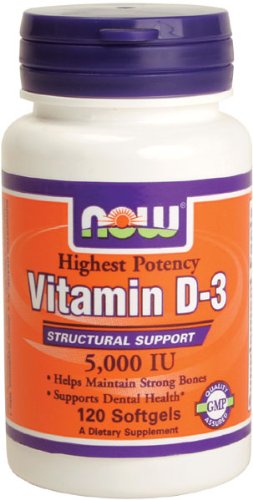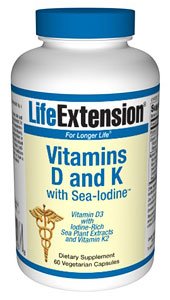In the 21st century, in one of the most developed nations in the world, we have a vitamin deficiency of epidemic proportions. How is this possible, you may ask. We are extremely well fed, many of us take multi-vitamins, we drink our milk and eat our vegetables (most of the time). Furthermore, the US government has recommended daily allowances for vitamins that many of us try to get every day. How could we possibly be deficient in a vitamin?
Vit D Supplement
Despite the efforts of the government and food science industries to make sure we have plenty of everything, studies show that 40-60% of the entire US population is deficient in vitamin D.
Vit D Supplement
Historically, vitamin D deficiency resulted in rickets. Scientists determined the minimum amount of vitamin D and the government set the US Recommended Daily Allowance (RDA). Vitamin D was added to milk so the average child drinking the amount of milk recommended by the average pediatrician was guaranteed to get enough of the vitamin to prevent rickets, and we all were to live happily ever after.
It turns out Vitamin D is a critical nutrient for preventive maintenance of all of our body tissues, and recent research has shown the amount needed is far higher than the current US RDA.** Allowing your body to be deficient in vitamin D is like never changing the oil in your car. It runs just fine for a while, and then things simply begin to break down. Research has linked low levels of vitamin D to colorectal cancer, ovarian cancer, breast cancer, kidney cancer, type I and II diabetes, metabolic syndrome, melanoma, cardiovascular diseases (including heart attack, stroke and high blood pressure), periodontal disease, all autoimmune disorders, pre-eclampsia, difficult birthing, autism, and other diseases.** Let's be clear: low vitamin D does not CAUSE these diseases, but studies overwhelmingly show that people with these diseases have low serum (blood) levels of vitamin D, and that when the vitamin D level is brought into a normal range the prognosis is often 50% (or more) better than when the vitamin D level remains low.
How did we get so deficient? There are few dietary sources of vitamin D, including cod liver oil, egg yolks, butter, liver, oily fish, some fortified breakfast cereals, and milk. We tend to avoid strongly-flavored fishy foods in this culture, and we tend to minimize consumption of eggs and butter to lower our cholesterol. Vitamin D is manufactured in the skin from cholesterol, and requires Ultraviolet B (UVB) radiation for its synthesis. With the increased use of high SPF sunscreens (which completely block UVB radiation) and the increased use of cholesterol-lowering medication, we have severely limited our ability to manufacture vitamin D. Even without sunscreen, most of the US is far enough north of the equator that we receive limited amounts of UVB during most of the year. It is virtually impossible to get enough UVB to make vitamin D during the winter if you are north of the 35th parallel (think Atlanta or San Diego).
The US RDA for vitamin D is 400IU/day. Remember, the RDA for any nutrient is the MINIMUM amount required to prevent known deficiency disease, NOT the optimal amount needed for health. For years, the only known vitamin D deficiency disease has been rickets, and this amount of vitamin D is sufficient to prevent rickets. However, the latest research shows that for the disease prevention effect of vitamin D to be present, the blood level needs to be in the 60-80ng/ml range, more than double the current low end of the "normal" laboratory range for this nutrient.** To keep your blood vitamin D at this level requires 2000-2400IU/day from all sources for adults, 2000IU/day for children under 12, and 1000-1800IU/day for infants less than 1 year.
Vitamin D is fat soluble, so can't you get too much of it? The answer is yes, but you need a lot. Studies have demonstrated no toxicity with supplementation of vitamin D at levels as high as 20,000IU per day, so the levels recommended are well below the toxic dose for this vitamin.**
So, how do you get 2000IU of vitamin D per day? Most milk in the US has vitamin D added to it, so if you drink milk you are getting some vitamin D. 10-15 minutes of sun exposure on the arms and legs during the peak hours for UVB radiation (10am-2pm), without sunscreen, allows your body to make about half the vitamin D it needs. However, if you live north of the 35th parallel you will be unable to get enough UVB exposure to make enough vitamin D during much of the year. The good news is that vitamin D supplements exist and are relatively inexpensive. I recommend starting with 1000IU per day in a supplement for most people. If you don't drink milk and rarely get out in the sun, 2000-2500IU per day would be appropriate. Therapeutic doses can be much higher, and require periodic monitoring of your blood levels to make sure you don't overdose.
It is easy to test for vitamin D deficiency with a simple blood test which can be ordered by most health care providers. You can also be tested through D Action (unless you live in the State of NY!), an advocacy group with the goal of eliminating vitamin D deficiency in the world. You can sign up to participate in the D Action research project at http://www.grassrootshealth.org. and completion of a survey provides you with a vitamin D test, materials to send the test for processing, and a copy of the results.
**The list of research references for this article is almost 3 pages long, so it is not included in the newsletter. It can be accessed by clicking here.
Vitamin Deficiency Epidemic in the United States
Vit D Supplement
4G Flash Drive












